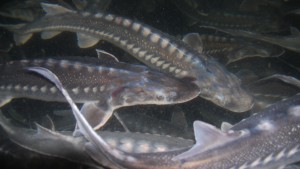
Sturgeons, the fish whose eggs are known as caviar, have been around for about 250 million years. These giants are the largest of the freshwater fish and have been known to grow to over 4,000 pounds and live more than 100 years. But it took us only a couple hundred years to deplete their stocks around the world, to the point where most caviar is now harvested from farmed sturgeon.
Caviar is generally associated with the Caspian Sea, the large land-locked body of water surrounded by Russia, Kazakhstan, Iran, Azerbaijan and Turkmenistan. Sturgeon are such big animals and the females produce so many eggs (in the wild, eggs can make up as much as 25 percent of their bodyweight) that historically they were a great source of protein. The caviar was for royalty, with the lightest-colored, blond caviar being reserved for the tsar, in Russia, and the shah, in Iran. But this year, virtually no wild-harvested caviar came out of that region.
Less known is the fact that in the late 1800s, the United States was a purveyor of wild-harvested caviar to the world.
“Here in California, they were harvesting millions of pounds in the late 1800s. And actually there was a town in New Jersey called Caviar, which was the world-leading exporter of caviar,” said Peter Struffeneger, general manager of Sterling Caviar, one of the two companies in California that farm sturgeon for caviar. “But within a span of 30 years they wiped it out. They closed down all fishing from about 1905 to the 1950s, 1960s, depending on which river, for the stocks to recover. And most of them have only gotten back to a point where there’s a limited sport fish for it.”
Two species of sturgeon are native to California: the white sturgeon and the green sturgeon. The green sturgeon is a threatened species and can’t even be fished by sport fishermen. Anglers in California can only catch three white sturgeon per year and need a special card from the state’s Department of Fish and Game to do so. White sturgeons have been plentiful in the Bay Area in 2011, according to this report. But sturgeon poaching remains a problem.